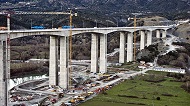Investor preferences and portfolio segmentation create anomalies
Given the low correlation between global listed infrastructure and the broader equity market, an allocation to this asset class can offer investors the important benefits of diversification. In addition to this, in recent years global listed infrastructure has delivered  higher risk-adjusted returns than the broader global equity market (14.9% per annum over five years, and 11.7% over 10 years)1, demonstrating its ability to provide robust performance over the long-term. As the asset class is still relatively young, and has only been around for approximately ten years, there is significant opportunity for investors to benefit from its relative inefficiency.
higher risk-adjusted returns than the broader global equity market (14.9% per annum over five years, and 11.7% over 10 years)1, demonstrating its ability to provide robust performance over the long-term. As the asset class is still relatively young, and has only been around for approximately ten years, there is significant opportunity for investors to benefit from its relative inefficiency.
Of the global listed infrastructure universe, less than 3% of stocks are held by dedicated global listed infrastructure managers with long-term investment horizons. The remainder is held by index funds and generalist managers that tend to make investment decisions based on short-term forecasts, which in our view is the wrong way to value infrastructure assets. This inefficiency can provide substantial opportunities for the specialist infrastructure investor to add value for the end investor. As the assets owned by global listed infrastructure companies benefit from long-term contracts or regulation, they deliver highly predictable and stable cash flows. This stability of cash flows allows for reliable dividends to be paid that grow at attractive rates, often above the level of inflation.
Valuation leads and lags arise between direct and listed
The need for infrastructure investment is a never-ending cycle. Investment in infrastructure helps stimulate sustainable long-term economic growth which then creates a further need for infrastructure. Many consultants have completed extensive research into global infrastructure investment needs, demonstrating the significant amount required. McKinsey forecasts that US$57 trillion investment is required on core infrastructure alone between 2012 and 2030 – just to keep up with expected economic growth. Governments who are already heavily indebted can’t afford to spend the money themselves. So, listed infrastructure companies have to be part of the solution to fund this shortfall and are well positioned to benefit from attractive investment opportunities. Although the asset class has performed well over the past few years, in 2015 it has traded below the sector’s long-term average, and is currently around 10-15% below the trend line. The last disconnect we saw of this magnitude was in 2008. Given the recent pull-back in the asset class, we believe this creates a great buying opportunity and entry point for the long-term investor.
Tim Humphreys, Head of Global Listed Infrastructure, AMP Capital
Tim Humphreys is the head of AMP Capital’s Global Listed Infrastructure team. He also leads the research effort of infrastructure companies in the Americas. Tim has over 19 years’ experience in the financial industry in the UK and Australia and is a skilled infrastructure analyst.
1. Source: Bloomberg. Total return in USD of Dow Jones Brookfield Global Listed Infrastructure Index as at 31 December 2014. Past performance is not a reliable indicator of future performance.
Source: AMP Capital
Important note: While every care has been taken in the preparation of this article, AMP Capital Investors Limited (ABN 59 001 777 591, AFSL 232497) and AMP Capital Funds Management Limited (ABN 15 159 557 721, AFSL 426455) makes no representations or warranties as to the accuracy or completeness of any statement in it including, without limitation, any forecasts. Past performance is not a reliable indicator of future performance. This article has been prepared for the purpose of providing general information, without taking account of any particular investor’s objectives, financial situation or needs. An investor should, before making any investment decisions, consider the appropriateness of the information in this article, and seek professional advice, having regard to the investor’s objectives, financial situation and needs. This article is solely for the use of the party to whom it is provided.



